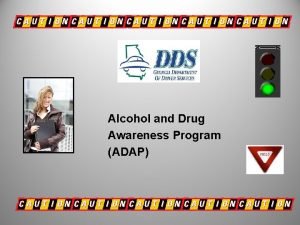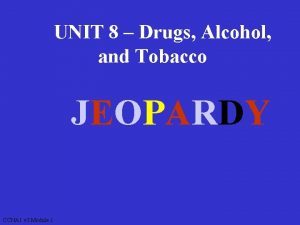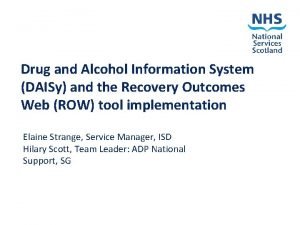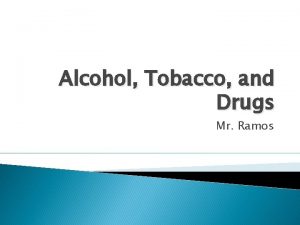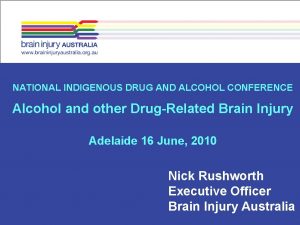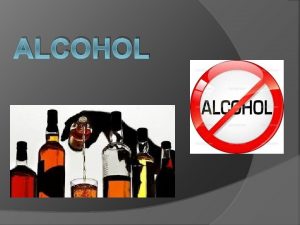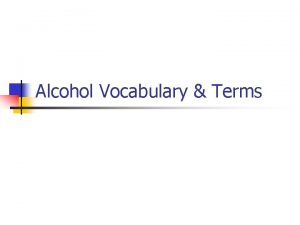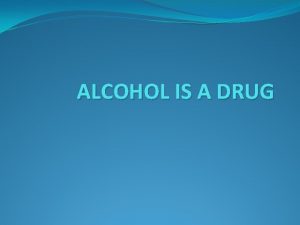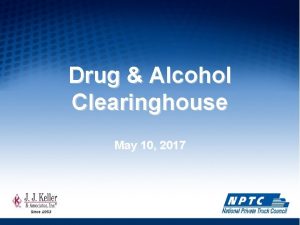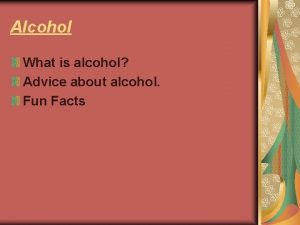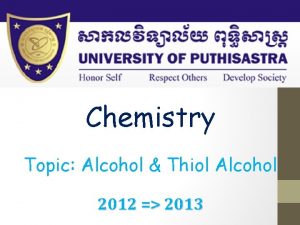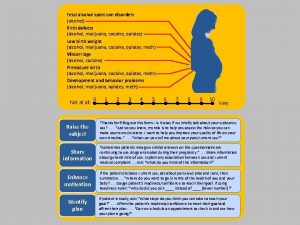The leading voice in Indigenous drug and alcohol
























- Slides: 24

The leading voice in Indigenous drug and alcohol policy About NIDAC Bridges and Barriers Indigenous incarceration and Health

The leading voice in Indigenous drug and alcohol policy advice Background 1998 – then Prime Minister established the Australian National Council on Drugs (ANCD). ANCD provides independent advice to the Australian Government on alcohol and drug policy and issues. 2004 – the ANCD established the National Indigenous Drug and Alcohol Committee (NIDAC) to support the ANCD in providing advice on addressing Indigenous drug and alcohol issues in Australia.

NIDAC Membership 2011 - 2014 The leading voice in Indigenous drug and alcohol policy advice Executive Committee Members Associate Professor Ted Wilkes – NIDAC Chair - Curtin University (WA) Ms Coralie Ober – NIDAC Deputy Co-Chair – University of Queensland (QLD) Mr Scott Wilson – NIDAC Deputy Co-Chair - Aboriginal Drug and Alcohol Council (SA) Ms Wendy Casey - Aboriginal Alcohol and Other Drugs, Drug and Alcohol Office (WA)

Committee Members Ms Donna Ah Chee – National Aboriginal Community Controlled Health Organisation (NACCHO) (ACT) Mr Matthew Bonson - Central Aboriginal Alcohol Program Services (CAAPS) (NT) Ms Viki Briggs – National Centre for Excellence in Indigenous Tobacco Control (CEITC) (VIC) Mr Bradley Freeburn – Aboriginal Medical Service , Redfern (NSW) Professor Dennis Gray – National Drug Research Institute, Curtin University (WA) Committee Members Ms Kristie Harrison – Aboriginal Drug and Alcohol Network Leadership, Aboriginal Health And Medical Research Council (ADAN , AHMRC) (NSW) Dr John Herron – Australian National Council On Drugs (ANCD) Chairman (QLD)

Governance structure to support the National Drug Strategy 2010 -2015 The leading voice in Indigenous drug and alcohol policy advice Prime Ministers Annual information meetings to discuss strategic issues as required Annual Reports Australian National Council on Drugs Intergovernmental Committee on Drugs Annual stakeholder forum Health Officials Law enforcement officials Of Substance Time –limited working groups Research and Data Working Group Workforce Development Working Group Aboriginal & Torres Strait Islander Peoples Drug Strategy Working Group Asia Pacific Drug Issues Committee National Indigenous Drug & Alcohol Committee Standing Committees Stakeholder and expert representation Research and Data Working Group

The leading voice in Indigenous drug and alcohol policy advice NIDAC’s Vision: An improved quality of life for Aboriginal and Torres Strait Islander people, families and communities that is consistent with that enjoyed by the majority of the Australian population, by reducing alcohol, tobacco and other drug related harms NIDAC’s Terms of Reference: § Provide expert policy advice to governments on Indigenous alcohol and other drug use and related harms § Engage and work closely with governments, NGOs, community controlled organisations and committees to respond to the harmful effects of alcohol and other drugs amongst Indigenous people § Promote the implementation of the National Drug Strategy Aboriginal and Torres Strait Islander Peoples' Complementary Action Plan 2003 -2009 § Provide regular reports to ANCD, and Australian Government § Provide expert advice in response to new and emerging issues that impact on Indigenous communities in addressing alcohol and other drug use.

The leading voice in Indigenous drug and alcohol policy Bridges & Barriers: Addressing Indigenous Incarceration & Health www. nidac. org. au

Figure 2: Ratio of Indigenous to non-Indigenous age-standardised rates of imprisonment a Indigenous offenders in Australia Indigenous and non-Indigenous prisoners, 2001 -2011 (rate per 100 000 relevant persons) 2000 1500 Indigenous 1000 Non-Indigenous 500 0 01 02 03 04 05 06 07 08 09 10 11 Ratio of Indigenous to non-Indigenous age-standardised rates of imprisonment (a) 20 15 10 5 0 NSW (a) Vic Qld Rate per 100, 000 adult population. Source: ABS National Prisoner Census 2011 SA WA Tas NT ACT Aust

Indigenous offenders in Australia • Indigenous adults are 14 times more likely to be imprisoned • Over 30% of all adult female prisoners in 2011 were Indigenous • 26% of all adult male prisoners were Indigenous • Indigenous women are 9 - 16 times more likely to come into contact with police and have legal action proceeded against them than non. Indigenous women, and Indigenous men 8 - 10 times more likely • 49% of young people in juvenile corrective institutions in 2010/11 were Indigenous • Indigenous young people are less likely to be cautioned and more likely to be arrested; after arrest they are more likely to be convicted and to receive custodial sentences Australian Bureau of Statistics 2011; Bartels 2010; AIHW 2012; Loh and Ferrante 2003; Richards 2009; Chan et al 2004; Snowball 2008; Wundersitz & Hunter 2005

Percentage of police detainees self reporting alcohol use in the 48 hours before arrest, by age and Indigenous status, 2010 70 60 50 40 30 20 10 0 Indigenous Non-Indigneous 18 -25 yrs 26 -30 yrs 31 -35 yrs 36+ yrs Percentage of police detainees testing positive to selected drugs, by Indigenous status, 2010 80 70 60 50 40 30 20 10 0 Indigenous Source: Australian Institute of Criminology, DUMA 2010 [Computer File]. M g yd ru e An Co ca in et h ad o ne e Bu pr en or ph in ia te s . Op i. . et M et ha m ph et a ph am es in m ze p Am ia Be nz od Ca nn in ab es is Non-Indigenous

Rate of juveniles in detention per 100, 000 population, 1994 -2011, by Indigenous status a, b 500 400 300 Indigenous 200 Non-Indigenous 100 98 19 99 20 00 20 01 20 02 20 03 20 04 20 05 20 06 20 07 20 08 20 09 20 10 20 11 97 19 96 19 95 19 19 19 94 0 a. Excludes Tasmania between 1997 -2002. b. Calculation methods were altered in 2009. • A high proportion of Indigenous juveniles in detention are on remand • Many of these young people will never receive a sentence • One quarter of the increase in the Indigenous imprisonment rate in NSW from 2001 to 2008 was due to increases in the remanded, nonsentenced population • Time spent on remand is a predictor of recidivism AIHW 2011; AIHW 2012; Murphy et al 2010; Fitzgerald 2009; Murphy et al 2010

Indigenous offender health On arrest • 74 % of Indigenous adult police detainees in 2011 tested positive to a range of drugs • 73% of Indigenous prison entrants reported drinking at levels of high risk in the 12 months preceding arrest, in contrast to 48% of non-Indigenous prison entrants • 68% of Indigenous prison entrants reported having used illicit drugs in the previous 12 months In prison • • • 89% of Indigenous male prisoners smoke tobacco daily, weekly or irregularly Male Indigenous prisoners are more likely to be dependent on alcohol or cannabis One third of injecting drug users continue to inject drugs while in prison Australian Institute of Health and Welfare 2011; Australian Institute of Criminology, DUMA Collection 2010 [Computer file] ; Putt et al. 2005; Dolan et al 2010; Moore 2011; Kratzman et al 2011

In Australian prisons • High-risk behaviours for BBV transmission are more prevalent in prisons • Hep. C levels are over 30 times greater than in the general community • In one Australian jurisdiction approx 60% females and 50% males with a substance use disorder also have a mental health disorder • In NSW Indigenous women were 12. 6 times, and Indigenous men 4. 8 times, more likely to die after release from prison, with 76% of ex-prisoner deaths in the two weeks after release drugrelated Heale et al 2003; Australian Government National Drug Strategy 2008; Kariminia, et al. 2007; Butler et al 2011; Bartels 2010; Merrall et al 2011

The system isn’t working! The reasons must be addressed to reduce incarceration rates • Socioeconomic factors • Cultural displacement, cultural well being issues • Alcohol and other drug misuse • Diversion barriers • Fetal alcohol spectrum disorders and acquired brain injury

Treatment is far more effective • The total cost per prisoner is approx $275 per day. • The cost per juvenile offender in custody is approx $652 per day in NSW • By comparison, the cost of residential rehabilitation is approx $98 per day. Productivity Commission 2011 Audit Office of NSW 2011 Moore et al. 2007

Alternative ways of thinking are needed to break the cycle • Every Indigenous young person should have an individual education support fund • Amend the eligibility criteria of current diversion programs • Establish a network of Indigenous-specific residential rehabilitation centres for courts to utilise as an alternative to incarceration • Improve the level of health services available to all Indigenous prisoners and juvenile detainees • Identify and support Indigenous-specific programs and best practices that are effective in reducing offending and re-offending

Key Short Term Recommendations • Amend the eligibility criteria of current diversion programs to not rule out offenders who have: prior convictions related to AOD, selective multiple charges, violent AOD-related offence convictions, and co-existing mental illness or health problems. • Appropriate Indigenous-specific programs to assist individuals and their family members post-release, including education on post-release health risks. • Improve the level of health services available to all Indigenous prisoners and juvenile detainees with links to Aboriginal community-controlled health services and Aboriginal drug and alcohol services • Provide every Indigenous young person with an individual education support fund to assist and promote their participation and retention within the education system. • Institute a trial of a needle and syringe program in an Australian correctional centre.

Key Long Term Recommendations • Fund a network of community-based Indigenous youth wellbeing and activity centres with links to education and health services. • Develop a national AOD campaign for Indigenous Australians to reduce demand supply, as well as decrease the incidence of fetal alcohol spectrum disorder. • Establish a ‘break the cycle’ network of Indigenous-specific residential rehabilitation centres for courts to utilise as a viable alternative to incarceration. • Further develop consistent nationwide access to Alcohol Courts, Drug Courts and other diversionary operations.

Justice Reinvestment

What Justice Reinvestment Is. . . • Involves shifting part of the spending away from imprisonment towards community-based programs and services. • Recognises that incarcerating a large proportion of the population creates conditions for a continuation of social disadvantage and further crime. • Retains prison as a measure for dangerous and serious offenders. • Identifies and targets communities where large numbers of offenders reside. • Provides a good investment – both socially and economically – by shifting money away from imprisonment and into services for disadvantaged communities.

What Justice Reinvestment Isn’t. . . • Differs from other more traditional ways of investing in areas of high crime rate such as: – law enforcement (e. g. more patrols, stricter enforcement). • Differs from restorative justice which includes a range of different practices, including apologies, restitution, and acknowledgments of harm and injury aimed at healing or restoration. • It does not pull funding from other essential programs.

Examples of Justice Reinvestment. . . • Funding of programs that focus on addressing underlying causes of crime e. g. AOD treatment. • Focus on poverty, education, housing, health care, and public amenities. • Texas (USA) - instead of building a new prison, funding was allocated to in-prison treatment programs and improved treatment probation and parole services which in turn led to savings which were reinvested into communities with a high proportion of offenders.

Barriers to Justice Reinvestment • Overcoming media, political and community support for a ‘Tough on Crime’ approach • Accepting a longer term approach for better community-wide outcomes

The leading voice in Indigenous drug and alcohol policy BRIDGES AND BARRIERS : Addressing Indigenous incarceration and health Copies can be obtained from: NIDAC Secretariat ( 02) 6166 9600 nidac@ancd. org. au or www. nidac. org. au
 Objectives of roving frame
Objectives of roving frame Arch hillingdon
Arch hillingdon What is tadra
What is tadra 12 core functions of addiction counseling
12 core functions of addiction counseling Drug and alcohol jeopardy
Drug and alcohol jeopardy Drug and alcohol information system (daisy)
Drug and alcohol information system (daisy) Centre county drug and alcohol
Centre county drug and alcohol Chapter 7 alcohol other drugs and driving
Chapter 7 alcohol other drugs and driving Drug and alcohol safety training
Drug and alcohol safety training Formation of alcohols
Formation of alcohols Carboxylic acid to tertiary alcohol
Carboxylic acid to tertiary alcohol Proh sub corr facil-alcohol/drug/phone/tobacco
Proh sub corr facil-alcohol/drug/phone/tobacco Why is alcohol considered a drug
Why is alcohol considered a drug Chapter 5 principles of voice leading answers
Chapter 5 principles of voice leading answers Deliberate adulteration examples
Deliberate adulteration examples Passive sentence pattern
Passive sentence pattern Voice change example
Voice change example Passive verb
Passive verb Chalie buarrawanga matjuwi
Chalie buarrawanga matjuwi Passive to active voice converter
Passive to active voice converter Present simple passive
Present simple passive Passive voice vs active voice
Passive voice vs active voice Indigenous axiology
Indigenous axiology Native color wheel
Native color wheel Indigenous science
Indigenous science


